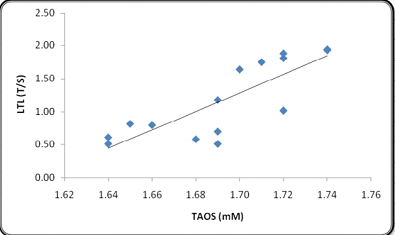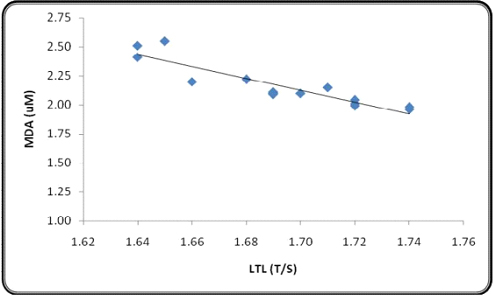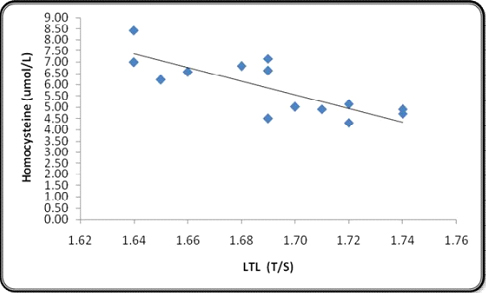Objective: Yoga is a mind-body modulation technique that has been shown to have beneficial effects on various diseases related to various systems in the body. However, the molecular basis of mechanism of action is not clear. Hence, this study was designed to study the leukocyte telomere biology and its relation with homocysteine and oxidative stress in yoga practitioners.
Materials and Methods: This is a prospective case-control study involving Yoga practitioners aged 30–40 y with minimum of two years yoga practice (Yoga group) and age, gender and body mass index matched sedentary healthy general population with no medical problems (Control group). Leukocyte telomere length (LTL) was measured by using quantitative PCR (qPCR), fasting plasma homocysteine was measured by a rapid high-performance liquid chromatography assay and the oxidative stress was assessed with total antioxidant status (TAOS), malondialdehyde (MDA) measured by calorimetry.
Results: The LTL was shorter in control group than in yoga group (p<0.001). The TAOS was more in yoga group when compared to control group (p<0.008), MDA and homocysteine was high in control group when compared to Yoga group (p<0.001). Further, the LTL was positively correlated with TAOS (r=0.841, p<0.001) and negatively correlated with MDA (r=-0.931, p<0.001) and Homocysteine (r=-0.756, p<0.001).
Conclusion: The LTL is well-preserved in people who practice Yoga regularly with lower systemic oxidative stress compared to those who have a relatively sedentary lifestyle despite lack of any medical disorders. The habitual yoga practice seems to inhibit replicative cellular senescence.
Introduction
Telomeres are the extreme ends of DNA, composed of a large number of tandem repeats of the series TTAGGG. Even though the role of telomeres are not completely recognized, these are responsible to maintain cellular stability [1,2]. Since DNA polymerase can’t fully complete the replication of the 3’ end of linear DNA, telomeres gradually diminish with repetitive cell division [3]. Earlier studies signified that, it is the potential mechanism for a biological clock determining cellular behaviour [4-6].
Moreover, the reduced telomere length was basically related with short lifespan as well as an array of ageing-related conditions like diabetes, cardiovascular disease, hypertension and dementia [7-10] and also showed that, oxidative stress and inflammation plays key role in the ageing and LTL can provide a record of the cumulative burden of oxidative stress and inflammation rather only existing metabolic status [11].
Yoga is fast emerging as an effective alternative and complementary medicine discipline that can result in a positive mind-body modulation [12]. Yoga in the form of Asanas (postures) and pranayama (breathing exercises) and Dhyana (meditation and relaxation) has been shown to be having positive effects on various systemic conditions including cardiovascular diseases [13]. Studies have demonstrated Yoga is a very effective adjunctive therapy in improving lipid profiles [14], blood pressure [15], psychological well-being, and even regression of atherosclerosis when combined with dietary and other lifestyle modifications [16,17], improves quality of life, functional capacity [17,18] cardiac function [19] heart rate, blood pressure, cardiac autonomic function [20] oxidative stress and inflammation in heart failure [21,22].
Even though, the positive effects of Yoga are demonstrated through disease specific outcomes, the exact underlying mechanisms are not very clear. There is evolving evidence behind the benefits of Yoga are perhaps related to decrease sympathetic surge with improved autonomic modulation, heart rate variability, decreased systemic stress and inflammation.
Data on the effects of Yoga on leukocyte telomere biology in yoga practitioners were limited and its correlation to systemic stress markers are not present. Therefore, this study was designed to assess the leukocyte telomere length (LTL) and its relation to oxidative stress and homocysteine levels in yoga practitioners.
Materials and Methods
Study design: This is a prospective case control study and approved by the Institute ethics committee.
Study population: Healthy Yoga practitioners within the age group of 30-40 y with no medical conditions and at least two years of Yoga practice constituted the study group (Yoga group n=15). The inclusion criteria consisted of 30-40 y with minimum two years of regular yoga practice which includes asana, pranayama and meditation. Subjects with chronic hypertension, known cardiovascular disease and any other systemic diseases were excluded from the study. Age, gender and body mass index matched general population with no known medical conditions and did not participate in any form of regular exercise activity other than activities of daily living were enrolled to be the control group (n=18).
Blood Sampling and measurement of Total antioxidant status (TAOS), Malondialdehyde (MDA) and Homocysteine levels:
Venous blood was collected and waited till it clot, centrifugation was done at 3,000 RPM at 4oC for 10 min (Remi-refrigerated centrifuge), the serum was separated and stored in at –80oC. TAOS and MDA, assessed in the form of Thiobarbituric acid reactive substances (TBARS) were analyzed by utilizing a commercially obtainable kit (Cayman chemical company, Michigan, USA). Total Homocysteine in Plasma was measured by Abbott IMX method.
Measurement of leukocyte telomere length (LTL)
Genomic DNA was extracted from blood samples by standard procedures [23] LTL was measured with a quantitative PCR which compares telomere repeat sequence copy number to single-copy gene (36b4) copy number in a given sample and expressed as telomere (T), single copy gene (S) ratio T/S [23]. All analyses were blinded to the participant's identity.
Statistical Analysis
Based on the assumption of a 20% or greater decrease in LTL in 5% of controls and at least 50% of the yoga practitioners, to obtain a power of 80% the required sample size was calculated as 15 subjects in each group. The data are expressed as mean ± SD. The data were examined for normality. Once normality was ensured, Independent ‘t’ test was used to test the difference between groups. Pearson’s correlation was used to test the association of LTL with TAOS, MDA, RER and Homocysteine levels. The null hypothesis was rejected at p<0.05. Results were analyzed with SPSS software v 16.0.
Results
All participants were reported to be free from cardiovascular disease, no regular medications, and no present or past history of smoking or alcohol intake.
The mean LTL length was significantly shorter in the control group (1.41 ± 0.06) than the yoga group (1.69 ± 0.03, p<0.001 ). The TOAS was significantly more in yoga group (control group: 0.70 ± 0.38, yoga group: 1.17 ± 0.57; p<0.008). The MDA and Homocysteine levels are significantly higher in the control group. MDA (control group: 4.05 ± 0.78, yoga group: 2.16 ± 0.18; p<0.001) and plasma homocysteine levels (control group: 9.77 ± 1.44, yoga group: 5.76 ± 1.27; p<0.001) were significantly lower in the control group compared to the yoga group [Table/Fig-1].
Between group differences of LTL, TAOA, MDA, Homocysteine
| S. No | Parameter | Yoga Group (n=15) | Control Group (n=18) | p-value |
|---|
| 1 | LTL (T/S) | 1.69 ± 0.03 | 1.41 ± 0.06 | <0.001 |
| 2 | TAOS (mM) | 1.17 ± 0.57 | 0.70 ± 0.38 | 0.008 |
| 3 | MDA (uM) | 2.16 ± 0.18 | 4.05 ± 0.78 | <0.001 |
| 4 | Homocysteine (umol/L) | 5.76 ± 1.27 | 9.77 ± 1.44 | <0.001 |
Data expressed as mean ± SD; LTL=Leukocyte telomere length; TAOS=Total antioxidant status; MDA=Malondialdehyde
The associations of LTL with TAOS, MDA and plasma homocysteine were depicted in [Table/Fig-2]. As shown in [Table/Fig-3,4], LTL was positively correlated with TAOS (r = 0.841; p < 0.001) and negatively correlated with MDA (r = - 0.931; p < 0.001), [Table/Fig-5] showed the negative correlation between LTL and homocysteine levels (r = - 0.756; p < 0.001).
Association of LTL with TAOS, MDA and Homocysteine
| S. No | Parameter | LTL |
|---|
| Yoga Group | Control Group |
|---|
| r-value | p-value | r-value | p-value |
|---|
| 1 | TAOS (mM) | 0.841 | <0.001 | 0.840 | <0.001 |
| 2 | MDA (uM) | - 0.931 | <0.001 | 0.161 | 0.524 |
| 3 | Homocysteine (umol/L) | - 0.756 | 0.001 | - 0.349 | 0.439 |
Data expressed as mean ± SD; LTL=Leukocyte telomere length; TAOS=Total antioxidant status; MDA=Malondialdehyde
Scatter plot showing the association between LTL and TAOS (r = 0.841; p = <0.001)

Scatter plot showing the association between LTL and MDA (r = - 0.931; p = <0.001)

Scatter plot showing the association between LTL and Homocysteine (r = - 0.756; p = 0.001)

Discussion
Major findings: 1. LTL length is well-preserved and is longer in people who practice yoga regularly. 2. The total antioxidant status, Malondialdehyde (MDA), and Homocysteine levels are lower with Yoga practice than those who don’t. 3. There is a negative correlation between the LTL and markers of systemic stress.
Yoga includes - physical postures asanas, breathing exercises (pranayama), meditation and relaxation (Dhyana). Regular practice of yoga enhances the depth of breathing as well as adjusts the chemoreceptive sensitivity [24]. The therapeutic potential of yoga in various diseases, especially for life-style-related were studied extensively. The key risk elements such as blood glucose, high cholesterol, overweight and high blood pressure, which usually associated with life-style-related conditions, can be reduced by yoga practice [25-27]. Yoga facilitated to improve physical function and reduced inflammatory markers in heart failure [21] and also useful in the diabetes management [28] asthma [29] chronic insomnia [30]. Many reports depict that yoga practice may reduce systemic stress, down regulate the hypothalamic-pituitary-adrenal axis, which helps to reduce sympathetic nervous system activity and enhance vagal activity [31].
The mechanism by which yoga may preserve the LTL is speculative at this time. Oxidative stress enhances the telomere erosion with cell replication [32] and short telomere length is associated with systemic oxidative stress [33]. In this study, we assessed oxidative stress by measuring TAOS which is the combined activity of all constituents, including vitamins, proteins, lipids, glutathione etc., and MDA which is a naturally occuring product of lipid peroxidation (LPO). LPO is a well established mechanism of cellular injury. In this present study the LTL was significantly associated with TAOS in both the groups, whereas, the LTL was significantly negatively correlated with MDA levels in yoga group, which indicates the reduction of LPO reduces cellular injury and it slows down the shortening process of LTL. Earlier studies reported the role of yoga in increasing the TAOS and reduction of MDA [34,35], our results are consistent with previous work. Further, negative association of LTL with homocysteine in yoga group indicates the proof for possible multisystem positive effects of yoga.
Study limitations and future implications: As this is a pilot cross sectional study without follow-up, we couldn’t note the exact yoga schedule, their diet pattern, and we didn’t recruit subjects with wide variation in the age to avoid the effect of age on LTL and this study cannot examine inter individual variability. This is a relatively small study whose results should be interpreted carefully. However, the results were compelling and form a solid basis to explain the possible positive benefits of Yoga on the human body. This study opens up many other questions as to the duration and intensity of Yoga needed to evoke this positive signal and how long these effects last. Further studies should conduct to study the effect and duration of yoga, type of practices on LTL overtime.
Conclusion
The LTL is well-preserved in people who practice Yoga regularly with lower systemic oxidative stress compared to those who have a relatively sedentary lifestyle despite lack of any medical disorders. The habitual yoga practice seems to inhibit replicative cellular senescence.
Data expressed as mean ± SD; LTL=Leukocyte telomere length; TAOS=Total antioxidant status; MDA=MalondialdehydeData expressed as mean ± SD; LTL=Leukocyte telomere length; TAOS=Total antioxidant status; MDA=Malondialdehyde
[1]. Blackburn EH, Structure and function of telomeres Nature 1991, 18 350(6319):569-73. [Google Scholar]
[2]. Zakian VA, Telomeres: beginning to understand the end Science 1995 270(5242):1601-07. [Google Scholar]
[3]. Harley CB, Futcher AB, Greider CW, Telomeres shorten during ageing of human fibroblasts Nature 1990 345(6274):458-60. [Google Scholar]
[4]. Olovnikov AM, A theory of marginotomy. The incomplete copying of template margin in enzymic synthesis of polynucleotides and biological significance of the phenomenon J Theor Biol 1973 41(1):181-90. [Google Scholar]
[5]. Allsopp RC, Vaziri H, Patterson C, Goldstein S, Younglai EV, Futcher AB, Telomere length predicts replicative capacity of human fibroblasts Proc Natl Acad Sci U S A 1992 89(21):10114-18. [Google Scholar]
[6]. Vaziri H, Dragowska W, Allsopp RC, Thomas TE, Harley CB, Lansdorp PM, Evidence for a mitotic clock in human hematopoietic stem cells: loss of telomeric DNA with age Proc Natl Acad Sci U S A 1994 91(21):9857-60. [Google Scholar]
[7]. Cawthon RM, Smith KR, O’Brien E, Sivatchenko A, Kerber RA, Association between telomere length in blood and mortality in people aged 60 years or older Lancet 2003 361(9355):393-95. [Google Scholar]
[8]. Mainous AG 3rd, Codd V, Diaz VA, Schoepf UJ, Everett CJ, Player MS, Leukocyte telomere length and coronary artery calcification Atherosclerosis 2010 210(1):262-67. [Google Scholar]
[9]. Tentolouris N, Nzietchueng R, Cattan V, Poitevin G, Lacolley P, Papazafiropoulou A, White blood cells telomere length is shorter in males with type 2 diabetes and microalbuminuria Diabetes Care 2007 30(11):2909-15. [Google Scholar]
[10]. Demissie S, Levy D, Benjamin EJ, Cupples LA, Gardner JP, Herbert A, Insulin resistance, oxidative stress, hypertension, and leukocyte telomere length in men from the Framingham Heart Study Aging Cell 2006 5(4):325-30. [Google Scholar]
[11]. Aviv A, Leukocyte telomere length, hypertension, and atherosclerosis: are there potential mechanistic explanations? Hypertension 2009 53(4):590-91. [Google Scholar]
[12]. Harinath K, Malhotra AS, Pal K, Prasad R, Kumar R, Kain TC, Effects of Hatha yoga and Omkar meditation on cardiorespiratory performance, psychologic profile, and melatonin secretion J Altern Complement Med N Y N 2004 10(2):261-68. [Google Scholar]
[13]. Bulavin VV, Kliuzhev VM, Kliachkin LM, Lakshmankumar Zuikhin ND, Vlasova TN, [Elements of yoga therapy in the combined rehabilitation of myocardial infarct patients in the functional recovery period] Vopr Kurortol Fizioter Lech Fiz Kult 1993 (4):7-9. [Google Scholar]
[14]. Mahajan AS, Reddy KS, Sachdeva U, Lipid profile of coronary risk subjects following yogic lifestyle intervention Indian Heart J 1999 51(1):37-40. [Google Scholar]
[15]. Selvamurthy W, Sridharan K, Ray US, Tiwary RS, Hegde KS, Radhakrishan U, A new physiological approach to control essential hypertension Indian J Physiol Pharmacol 1998 42(2):205-13. [Google Scholar]
[16]. Ornish D, Can lifestyle changes reverse coronary heart disease? World Rev Nutr Diet 1993 72:38-48. [Google Scholar]
[17]. Biman Bihari Paul, Effect of shavasan practices on coronary heart patients with special reference to shavsana and meditation Int Sci Yoga J Sense 2011 1(1):86-91. [Google Scholar]
[18]. Bandi Hari Krishna, Pal Pravati, Pal GK, Balachander J, Jayasettiasselon E, Srrekanth Y, Yoga improves quality of life and functional capaci ty in heart failure patients Biomed Res 2014 25(2):178-82. [Google Scholar]
[19]. Bandi Hari Krishna, Pal Pravati, Pal Gopal Krushna, Balachander J, Jayasettiaseelon E, Sreekanth Y, A Randomized Controlled Trial to Study the Effect of Yoga Therapy on Cardiac Function and N Terminal Pro BNP in Heart Failure Integr Med Insights 2014 :1-6. [Google Scholar]
[20]. Bandi Hari Krishna, Pal Pravati, Pal GK, Balachander J, Jayasettiaseelon E, Sreekanth Y, Effect of yoga therapy on heart rate, blood pressure and cardiac autonomic function in heart failure J Clin Diagn Res JCDR 2014 8(1):14-16. [Google Scholar]
[21]. Pullen PR, Nagamia SH, Mehta PK, Thompson WR, Benardot D, Hammoud R, Effects of yoga on inflammation and exercise capacity in patients with chronic heart failure J Card Fail 2008 14(5):407-13. [Google Scholar]
[22]. Bandi Hari Krishna, Pal Pravati, Pal GK, Sridhar MG, Balachander J, Jayasettiasselon E, Yoga Training In Heart Failure (NYHA I - II) R educes O xidative S tress and Inflammation J Exerc Physiol Online 2014 17(1):10-18. [Google Scholar]
[23]. Cawthon RM, Telomere measurement by quantitative PCR Nucleic Acids Res 2002 30(10):e47 [Google Scholar]
[24]. Bernardi L, Sleight P, Bandinelli G, Cencetti S, Fattorini L, Wdowczyc-Szulc J, Effect of rosary prayer and yoga mantras on autonomic cardiovascular rhythms: comparative study BMJ 2001 323(7327):1446-49. [Google Scholar]
[25]. Yang K, A Review of Yoga Programs for Four Leading Risk Factors of Chronic Diseases Evid-Based Complement Altern Med ECAM 2007 4(4):487-91. [Google Scholar]
[26]. Bijlani RL, Vempati RP, Yadav RK, Ray RB, Gupta V, Sharma R, A brief but comprehensive lifestyle education program based on yoga reduces risk factors for cardiovascular disease and diabetes mellitus J Altern Complement Med N Y N 2005 11(2):267-74. [Google Scholar]
[27]. McCaffrey R, Ruknui P, Hatthakit U, Kasetsomboon P, The effects of yoga on hypertensive persons in Thailand Holist Nurs Pract 2005 19(4):173-80. [Google Scholar]
[28]. Vaishali V, Agte KT, Sudarshan Kriya Yoga for Treating Type 2 Diabetes: A Preliminary Study Altern Complement Ther 2004 10(4):220-22. [Google Scholar]
[29]. Nagarathna R, Nagendra HR, Yoga for bronchial asthma: a controlled study Br Med J Clin Res Ed 1985 291(6502):1077-79. [Google Scholar]
[30]. Khalsa SBS, Treatment of Chronic Insomnia with Yoga: A Preliminary Study with Sleep–Wake Diaries Appl Psychophysiol Biofeedback 2004 29(4):269-78. [Google Scholar]
[31]. Lakkireddy D, Atkins D, Pillarisetti J, Ryschon K, Bommana S, Drisko J, Effect of yoga on arrhythmia burden, anxiety, depression, and quality of life in paroxysmal atrial fibrillation: the YOGA My Heart Study J Am Coll Cardiol 2013 61(11):1177-82. [Google Scholar]
[32]. Tchirkov A, Lansdorp PM, Role of oxidative stress in telomere shortening in cultured fibroblasts from normal individuals and patients with ataxia-telangiectasia Hum Mol Genet 2003 12(3):227-32. [Google Scholar]
[33]. Valdes AM, Richards JB, Gardner JP, Swaminathan R, Kimura M, Xiaobin L, Telomere length in leukocytes correlates with bone mineral density and is shorter in women with osteoporosis Osteoporos Int J Establ Result Coop Eur Found Osteoporos Natl Osteoporos Found USA 2007 18(9):1203-10. [Google Scholar]
[34]. Sinha S, Singh SN, Monga YP, Ray US, Improvement of glutathione and total antioxidant status with yoga J Altern Complement Med N Y N 2007 13(10):1085-90. [Google Scholar]
[35]. Yadav RK, Ray RB, Vempati R, Bijlani RL, Effect of a comprehensive yoga-based lifestyle modification program on lipid peroxidation Indian J Physiol Pharmacol 2005 49(3):358-62. [Google Scholar]